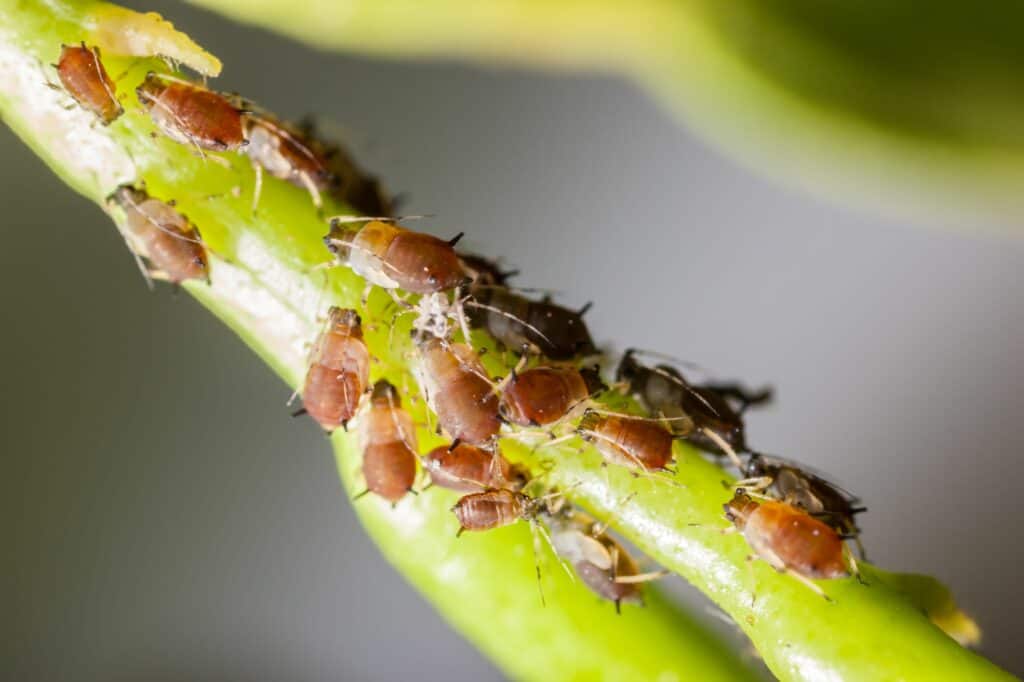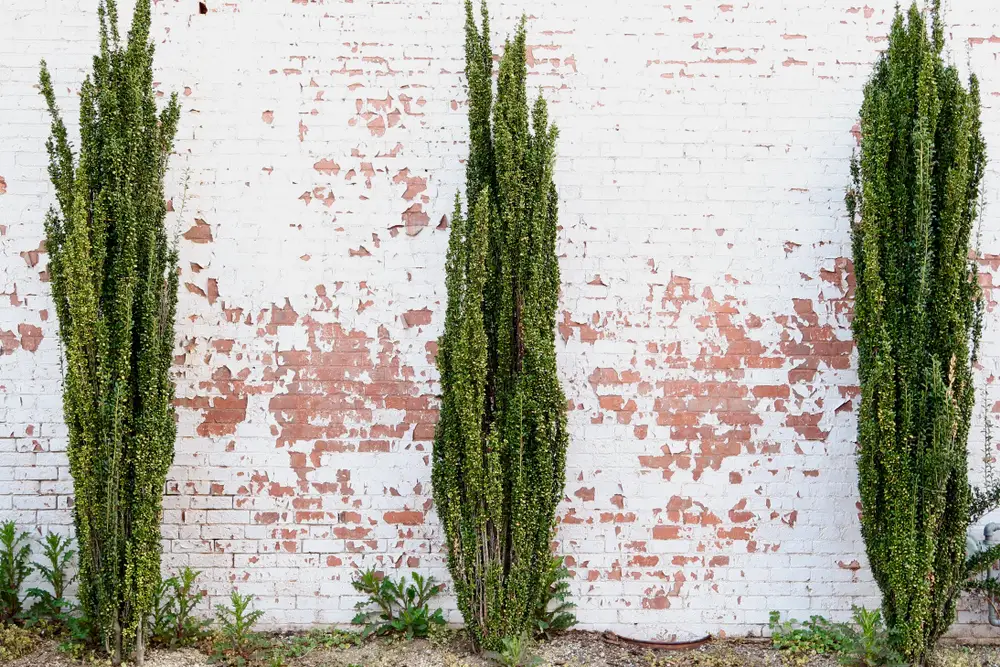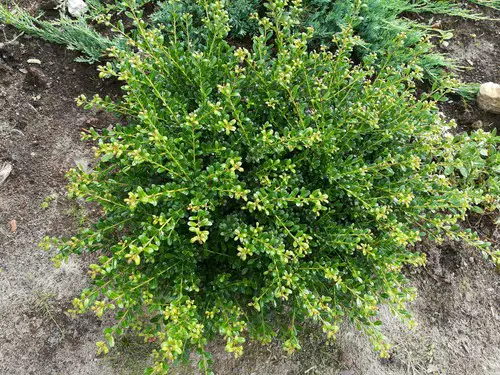Sky Pencil Holly is a popular evergreen shrub with a columnar shape that adds a unique touch to any garden. However, if you notice that your Sky Pencil Holly is turning brown, it could be a sign of a problem.
Brown leaves on Sky Pencil Holly can be caused by several factors, including overwatering, leaf burning, and infestation by spider mites.
To understand the reasons behind your pencil holly turning brown, it’s important to know a little about the plant. Sky Pencil Holly is a slow-growing evergreen shrub that can reach up to 10 feet in height.
It has a narrow, columnar shape with dark green foliage that grows in a tight, compact pattern. While Sky Pencil Holly is generally a hardy plant, it can be susceptible to certain problems that can cause the leaves to turn brown.
Some of the most common problems that can cause Sky Pencil Holly to turn brown include overwatering, leaf burning, and spider mite infestations. Overwatering can cause the roots to rot, which can lead to brown leaves.
Leaf burning can be caused by exposure to direct sunlight or by using too much fertilizer. Spider mites are tiny pests that feed on the leaves of Sky Pencil Holly, causing them to turn brown and fall off. Proper care and maintenance can help prevent these problems and keep your Sky Pencil Holly healthy.
Key Takeaways on Pencil Holly Turning Brown
- Sky Pencil Holly is a slow-growing evergreen shrub with a columnar shape.
- Brown leaves on Sky Pencil Holly can be caused by overwatering, leaf burning, and spider mite infestations.
- Proper care and maintenance, including proper watering and fertilization, can help prevent these problems and keep your Sky Pencil Holly healthy.
Check out these other top picks:
Understanding Pencil Holly

The Basics of Pencil Holly
Pencil holly, also known as sky pencil holly, is a type of evergreen shrub that belongs to the holly family. It is native to Japan and is widely cultivated as an ornamental plant in gardens and landscapes.
Pencil holly is characterized by its narrow, columnar shape, which makes it an excellent choice for planting in tight spaces or as a vertical accent in a garden.
The leaves of pencil holly are small, glossy, and dark green in color. The plant produces small, white flowers in the spring, which are followed by red berries in the fall. Pencil holly is a slow-growing plant and can reach a height of up to 10 feet when fully mature.
Ideal Conditions for Growth
Pencil holly is a hardy plant that can grow in a wide range of conditions. However, it thrives in well-drained soil that is rich in organic matter. The plant prefers full sun to partial shade and requires regular watering during the growing season.
It is important to avoid overwatering pencil holly, as this can lead to root rot and other problems.
Pencil holly is a low-maintenance plant that requires little pruning. However, it is important to remove any dead or damaged branches to promote healthy growth. Fertilizer is not necessary for pencil holly, but a light application of a balanced fertilizer in the spring can help to promote healthy growth.
In conclusion, pencil holly is a beautiful and versatile plant that can add vertical interest to any garden or landscape. By providing it with the right growing conditions, it can thrive for many years and provide year-round interest with its evergreen foliage.
Pencil Holly Turning Brown – 4 Common Problems of Pencil Holly
Pencil holly is a popular shrub, but it can experience a variety of problems that cause it to turn brown. Understanding these issues can help you keep your pencil holly healthy and vibrant.
1. Watering Issues
One of the most common problems with pencil holly is watering. Overwatering can lead to root rot, which can cause the foliage to turn brown and wilt.
Underwatering can also cause the leaves to turn brown and dry out. It’s important to water your pencil holly regularly, but not too much. Make sure the soil is moist, but not waterlogged.
2. Pests and Diseases

Pencil holly can be susceptible to a variety of pests and diseases. Spider mites, aphids, and scale insects can all infest the plant and cause the leaves to turn brown.
Fungal diseases like leaf spot, web blight, and botryosphaeria canker can also cause browning leaves and other symptoms. Neem oil, insecticides, and fungicides can all be effective treatments for these issues.
3. Environmental Factors
Pencil holly can also be affected by environmental factors like high temperatures, dry wind, and full sun. In these conditions, the plant may struggle to retain moisture and nutrients, which can cause the leaves to turn brown and dry out.
Providing shade, windbreaks, and proper drainage can all help protect your pencil holly from these issues.
4. Nutrient Deficiencies
If pencil holly isn’t getting enough water and nutrients, it may start to show signs of stress. This can cause the leaves to turn yellow or brown and the plant to produce less new growth. Providing proper water and nutrients can help prevent these issues and keep your pencil holly healthy.
The Impact of Soil and Location
The health of a Sky Pencil Holly plant can be greatly impacted by the soil and location it is planted in. The plant prefers well-drained soil that is not too heavy in clay or sand.
If the soil is too heavy in clay, it can cause the roots to suffocate and lead to the plant turning brown. On the other hand, if the soil is too sandy, it can cause the plant to dry out and also lead to browning.
When planting a Sky Pencil Holly, it is important to consider the location. The plant prefers a location that receives partial sun or shade, as too much direct sunlight can cause the plant to dry out and turn brown. In addition, afternoon sun can be particularly harmful to the plant and should be avoided if possible.
The plant also benefits from being planted in an area with good air circulation. This helps prevent fungal diseases that can cause browning.
Mulching can also have an impact on the health of a Sky Pencil Holly. Organic mulch can help retain moisture in the soil and provide nutrients to the plant.
However, if the mulch is too close to the trunk of the plant, it can cause the bark to rot and lead to browning. It is recommended to keep the mulch a few inches away from the trunk of the plant.
Iron deficiency can also cause browning in Sky Pencil Holly plants. This can be remedied by adding iron to the soil or using a fertilizer that is rich in iron.
Proper Care and Maintenance

To keep your Sky Pencil Holly healthy and prevent it from turning brown, proper care and maintenance are crucial. Gardeners should provide the plant with optimal growing conditions, including the right amount of water, sunlight, and nutrients.
Sky Pencil Holly grows best in partial shade but can tolerate full sun if given supplemental water during dry spells. The plant prefers well-draining soil that is rich in organic matter. Gardeners should avoid overwatering the plant, which can lead to root rot and browning leaves.
Pruning is not necessary for Sky Pencil Holly, but it can be done to maintain a specific height or width. Gardeners should prune in the winter when the plant is dormant and avoid pruning more than one-third of the plant at a time. Pruning can also stimulate growth and improve the plant’s overall health.
Fertilizing Sky Pencil Holly with a balanced fertilizer in the spring can provide the plant with the necessary nutrients for healthy growth. Gardeners should use one pound of 10-6-4 or special broadleaf evergreen fertilizer per inch of trunk diameter.
Propagation of Sky Pencil Holly can be done through stem cuttings taken in the summer. The cuttings should be dipped in rooting hormone and planted in well-draining soil. The plant will also benefit from supplemental water during the rooting process.
Conclusion
The most common reasons for Sky Pencil Holly turning brown are overwatering, leaf burning, and infestation by spider mites. Overwatering can lead to root rot, which causes the leaves to turn brown and wilt.
Leaf burning occurs when the plant is exposed to direct sunlight or hot temperatures for too long. Spider mites, on the other hand, are tiny pests that feed on the plant’s leaves, causing them to turn brown and dry.
Other factors that can contribute to Sky Pencil Holly turning brown include fungal diseases such as cankers, root rot, and powdery mildew.
These diseases can cause leaves to wither, develop unsightly spots, or turn an unappealing shade of brown. To prevent fungal diseases, it is important to keep the plant’s foliage dry and avoid overwatering.
To maintain healthy Sky Pencil Holly plants, it is important to provide them with the right growing conditions. They prefer well-draining soil and partial shade, although they can tolerate full sun in cooler climates. Regular pruning can also help to prevent overcrowding and promote healthy growth.
Frequently Asked Questions
How do I prevent my Sky Pencil Holly from turning brown?
To prevent your Sky Pencil Holly from turning brown, ensure that it is not overwatered. Sky Pencil Hollies are susceptible to root rot, so it is important to avoid overwatering. Additionally, ensure that the holly is planted in well-draining soil and receives ample sunlight.
What are some alternatives to Sky Pencil Holly?
If you are looking for alternatives to Sky Pencil Holly, consider other holly varieties such as Nellie R. Stevens Holly or American Holly. Other options include boxwood, juniper, or arborvitae.
How do I save a dying Sky Pencil Holly?
To save a dying Sky Pencil Holly, first identify the cause of the problem. If it is due to overwatering, reduce the frequency of watering and ensure that the soil is well-draining. If the holly is infested with pests or diseases, consult with a professional gardener or arborist for treatment options.
Why are the leaves on my Sky Pencil Holly turning yellow?
The leaves on a Sky Pencil Holly may turn yellow due to a variety of reasons, including overwatering, nutrient deficiencies, or pests and diseases. It is important to identify the underlying cause and address it promptly to prevent further damage.
Why is my Holly turning brown and dying?
There are several reasons why your Holly may be turning brown and dying, including overwatering, root rot, nutrient deficiencies, pests, and diseases. It is important to identify the underlying cause and address it promptly to prevent further damage.
What pests or diseases commonly affect Sky Pencil Holly?
Spider mites and scale insects are common pests that can infest Sky Pencil Holly. Diseases such as root rot and leaf spot can also affect the plant.
Ensure that the plant is properly cared for and consult with a professional gardener or arborist if you notice any signs of infestation or disease.

Hey, I’m Lisa and I’ve been an avid gardener for over 30 years. I love writing, talking and living in the garden! Feel free to connect with me on my socials below


